How Long Did the Blackout Continue
What would happen in an apocalyptic blackout?
(Image credit:
Getty Images
)
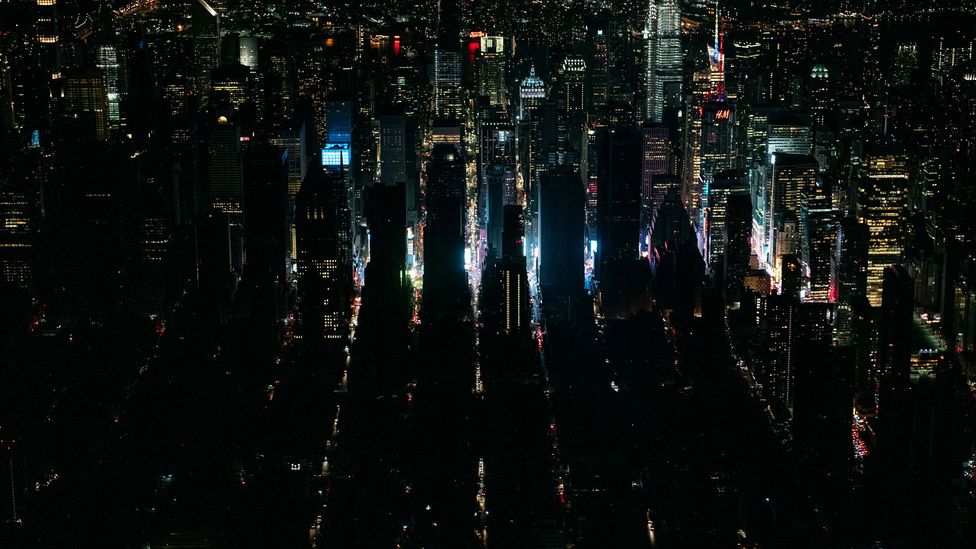
As hospital patients in Venezuela found out earlier this year during a five-day nationwide blackout, power cuts can do more than just turn out the lights.
T
There was nothing the doctors could do. In almost total darkness, broken only by the beam of a couple of torches and the glow from their mobile phones, the hospital staff watched helplessly as their patient died in front of them. The elderly woman was suffering a blood clot in her lungs – a common, but life-threatening problem that can be treated with the right drugs and equipment.
Everything the doctors needed to save the woman – including a mechanical ventilator – was tantalisingly close, in the intensive care unit several floors below. But with no power in the nine-floor hospital in Maracay, they had no way to reach it. Without electricity the lifts did not work.
It was a situation being played out in hospitals dotted all over Venezuela in March 2019 during a five-day nationwide power black out that accompanied the growing political and economic crisis facing the South American country. Unprepared for the sudden loss of power, back-up generators in some hospitals failed while others only had enough energy to keep a few of the most vital wards functioning.
By the end of the five days an estimated 26 people had died in the country's hospitals as a result of the power outage, according to figures collated by Doctors for Health, a group of concerned medics that have been monitoring the growing health crisis in Venezuela. Among those who died were kidney failure patients who could not get the vital dialysis treatment they needed, and gunshot victims on whom surgeons could not operate in the near darkness.
You might also like:
• The small Scottish isle leading the world in electricity
• Ten simple ways to act on climate change
• The biggest energy challenges facing humanity
Alongside the deaths were stories of pregnant women giving birth in dark hospital wards, doctors treating patients and surgeons performing operations using their mobile phones as torches, and babies in failing incubators.
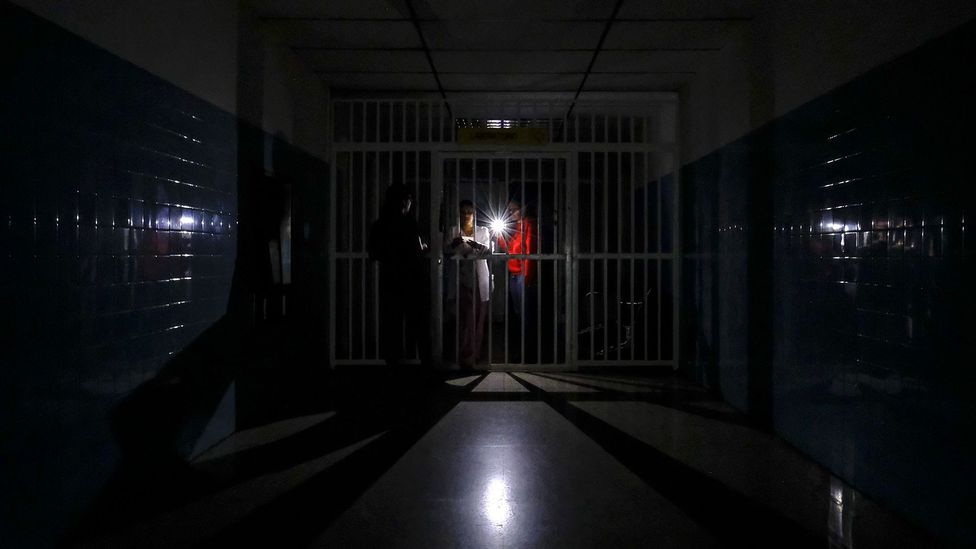
Hospitals over Venezuela lost power during a five-day nationwide black out this year (Credit: Getty Images)
"These babies need special care and without electricity for the incubators staff in neonatal units had to find blankets to keep the babies warm," says Julio Castro, from the school of medicine at the Central University of Venezuela, who has been compiling the data for Doctors for Health, describing some of the stories that hospital staff had told him about the power outages.
"When the ventilators failed, the nurses and doctors had to do it manually by squeezing a rubber lung," he says. "They were taking it in turns to keep these patients alive."
The problems extended beyond the hospitals. Elderly people in high-rise flats had to be carried down stairs. People cooked food with fire and ate by candlelight. Without power, food spoiled in warming refrigerators, traffic lights failed and transport systems ground to a halt. The pumps that drove running water to people's homes stopped, sending residents on a desperate search for water in nearby rivers, streams and even sewers.
Throughout the year, Venezuela has been plagued with power outages. Some are short and localised, lasting just a few minutes, others take hours for the power to come back, but some go on for days. As they have continued, Castro and his colleagues have recorded more deaths as a result.
"If you have even four hours without electricity in a hospital, it is far from normal," says Castro. "The situation with the water is even worse. There are some hospitals that are having to ask patients to bring in their own water with them because they simply cannot get enough supply."
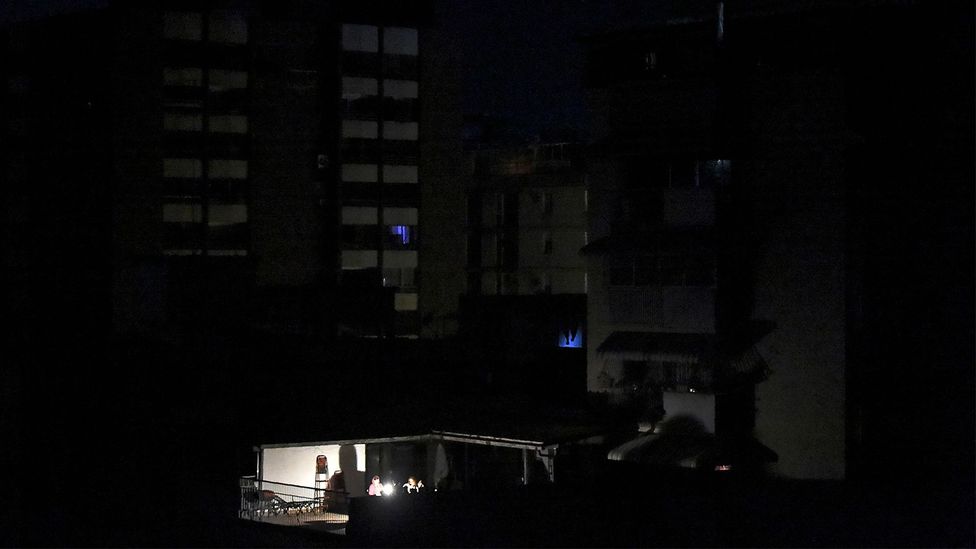
The blackouts in Venezuela hit people's homes, causing pumps powering running water to stop and food to spoil in fridges. (Credit: Getty Images)
The situation he describes seems almost apocalyptic in a country that until a few years ago was one of the richest in South America and has the largest proven oil reserves in the world. Although the Venezuelan government blames sabotage and terrorists for the blackouts, others have pointed to years of poor investment and neglect of the country's power grids as the cause.
But such widespread and long lasting power cuts, known as black sky events, are not restricted to countries teetering on the brink of collapse. Each year millions of people in the US and Canada are plunged into darkness by passing storms that bring down power lines.
In June 2019, almost all of Argentina, Uruguay and Paraguay were hit by a power outage that left nearly 40 million people without electricity. In August, almost a million people in the UK were left without power, trapping commuters on busy trains, when lightning strikes caused a gas-fired power plant and an offshore wind farm to shut down simultaneously.
These events, however, are minor in comparison to the kind of power outages that experts fear could be in store in the future. Growing demand on our electricity supplies from rising populations and new technologies like electric cars will face increasing instability as we shift to more renewable, but intermittent energy sources like wind and solar power. Extreme weather events driven by climate change will only heighten the risk to our power supplies further.
"So much of our lives and almost everything we do is now dependent on energy, and particularly on our electricity supplies," says Juliet Mian, technical director of the Resilience Shift, an initiative to help organisations and individuals prepare for failures in critical infrastructure. "We used to use the phrase 'when the lights go out', but the lights not working are the least of our worries now."
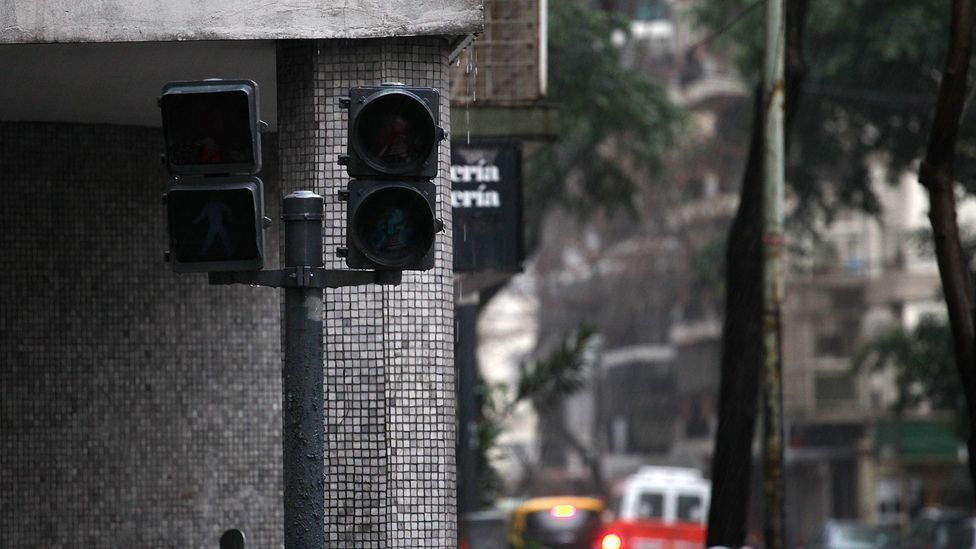
Traffic lights are just one of the aspects of transport infrastructure affected in huge power cuts. (Credit: Getty Images)
She is right. While the term "black sky" events illustrates perhaps the most visible impact of widespread power failures, it fails to convey the scale of the impact these can have. In our modern world, almost everything, from our financial systems to our communication networks, are utterly reliant upon electricity. Other critical infrastructure like water supplies and our sewer systems rely upon electric powered pumps to keep them running. With no power, fuel pumps at petrol stations stop working, road signs, traffic lights and train systems go dead. Transport networks grind to a halt.
Our complex food supply chains quickly fall apart without computers to coordinate where produce needs to be, or the fuel to transport it or refrigeration to preserve it. Air conditioning, gas boilers and heating systems also rely upon electricity to work.
A little over 100 years ago, our cities ran on human and animal muscle power to ferry goods and waste around. Modern infrastructure is now utterly reliant upon electricity.
"In today's world, our systems are highly interdependent and it is very hard to find many systems that are not fundamentally reliant upon power," says Mian. "A black sky scenario will affect everyone."
The causes of a black sky event are many. They vary from natural disasters like hurricanes or earthquakes to geomagnetic storms triggered by enormous flares from the Sun, or coronal mass ejections, that send a barrage of electrically charged particles racing across the Solar System and can overload electrical grids. One intense geomagnetic disturbance caused a nine-hour outage across large areas of Canada in 1989.
The Electric Infrastructure Security Council, an international body that reviews threats to power grids, also lists a number of human threats that can trigger a mass black out. These include cyberterrorism attacks or coordinated physical assaults on energy infrastructure such as power stations, and electromagnetic pulses that can disable electricity grids.
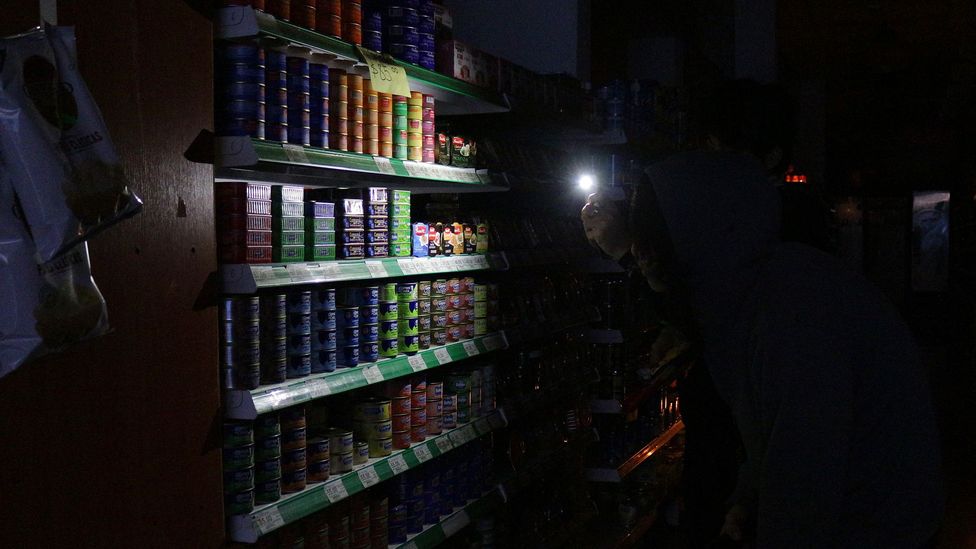
People use phones to illuminate goods in a supermarket in Buenos Aires, Argentina during a power cut (Credit: Getty Images)
"Our national power grids are tremendous feats of engineering and operations that have supported rapid economic growth around the world," say Melissa Lott, a research fellow at the Center on Global Energy Policy at Columbia University in New York. "But more investment is needed if electric power grids are going to keep up with rapid technology shifts and increasingly extreme weather events."
She says that while true black sky events are mercifully rare, the deep impact they have on businesses and people means more needs to not only update grid technology and management, but also improve infrastructure so it can be more resilient against physical threats like flooding.
"In the summer of 2012, blackouts in India cut power to more than 600 million people over two days. In Puerto Rico, Hurricane Maria crippled infrastructure across the island, leaving people in the dark and triggering a humanitarian crisis. In 2018, an earthquake on Japan's Hokkaido island left more than 5 million people without power. In order to keep these events from becoming more common and to minimise their impact, we need to invest in our grids."
Putting measures in place to counter all of these potential threats is difficult and expensive. Critical systems can be guarded from human attacks and they can be shielded from electromagnetic pulses with enough money being spent on them. Building new systems for protecting transformers from coronal mass ejections can also help to keep systems safe.
But there are some events that cannot be planned for and the complex, interconnected nature of our electricity grids are remarkably vulnerable. Take what happened in September 2003 when a fallen tree brought down a power line in Switzerland's Lukmanier Pass over the Alps into Italy and 24 minutes later another tree came down onto a line in the nearby Great St Bernard pass. The sudden failure of these two key lines caused other connections to Europe's electricity network to trip, which triggered power plants across Italy to shut down. The whole of Italy was left without power because of two fallen trees starting a cascade of events.
Modern electricity grids are increasingly interconnected and complicated, making failures like this difficult to predict. Most of Europe now runs off a massive interconnected power grid – probably the largest in the world – that supplies more than 400 million customers in 24 countries. The USA is made up of five different grids.
But there are some that are seeking ways of anticipating potential power failures and are enlisting the help of artificial intelligence to help them grapple with this highly complex problem.
When a power plant goes down, for example, it causes an abrupt spike in load on others on the network, which in turn slows down the generators at these plants and causes the frequency held on the grid to decrease. This risks destabilising the delicate balance that electricity grids are held in, and operators have to deploy countermeasures rapidly – often within milliseconds – to prevent sections of the grid being cut off.
Researchers at the Fraunhofer Gesellschaft research institute in Ilmenau, Germany, recently revealed they are developing an AI system to automatically detect these disturbances and take steps to address them.
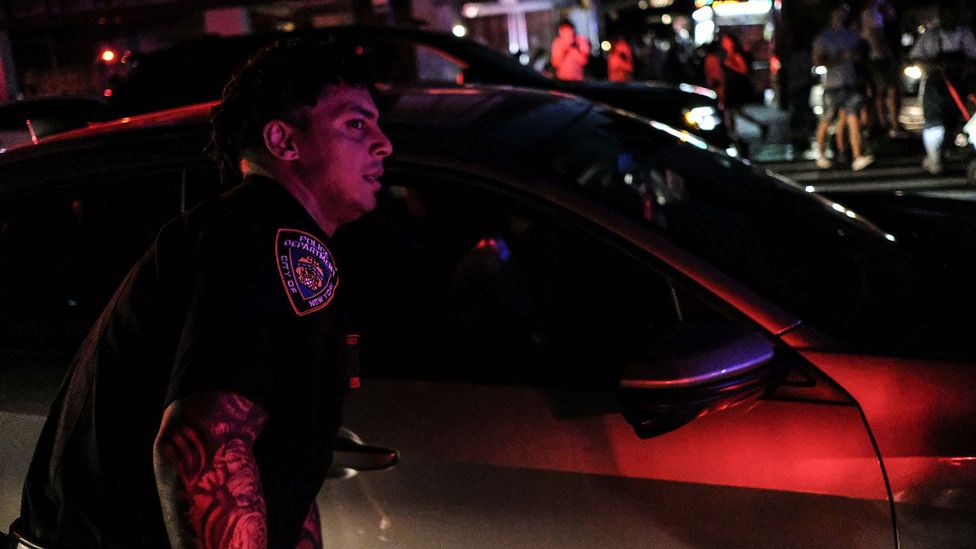
A major outage left both traffic and and subway users in Manhattan in the dark earlier this year. (Credit: Getty Images)
The US Department of Energy is also funding $7m (£5.4m) of research into using artificial intelligence to not only predict potential outages and spot anomalies that might lead to larger problems, but also to help find ways of keeping supplies constant in the event of a problem.
General Electric is using machine learning to help analyse weather forecasts past outage history and information on the ground from its response crews to predict the impact that impending storms might have on its networks. It is also using it to predict where its repair crews might need to be so that downed lines can be restored more quickly.
Power grids can also help to protect themselves by increasing the amount of energy storage such as large scale batteries they have available so that supplies can be supplemented when generators do go off-line unexpectedly.
But completely protecting our power networks from failures is almost impossible, says Mian.
"We can't necessarily design our systems so that failures don't happen," she says. "There's so much complexity in our systems these failures can cascade and they can become much more widespread, which means the failure is quite often unavoidable. But what we can do is design our systems so that they can respond and recover quickly."
This is what the Resilience Shift is now trying to improve. It has been organising exercises in collaboration with the Electric Infrastructure Security Council (EIS) that help large organisations, universities, schools, community groups and even families prepare themselves for an event that might lead to mass power cuts for several days at a time.
The Emergency All-sector Response Transnational Hazard Exercise, or Earth Ex, is an online exercise that allows people to rehearse the decisions they need to make and put in place the plans they need should the worst happen. (Try Earth Ex for yourself and see how prepared you are.)
"We want people to be thinking about these things long before there is a problem," says John Heltzel, director of resilience planning at the EIS. "It's important because when the electricity grid fails, there is this risk of cascading impacts that can occur from what might at first seem to be a relatively minor event.
This cascade effect is where the real damage can be done. As the people of Venezuela have discovered, even basic service like water can stop when the power goes out.
"It's effectively [like going] back to the dark ages," says Heltzel.
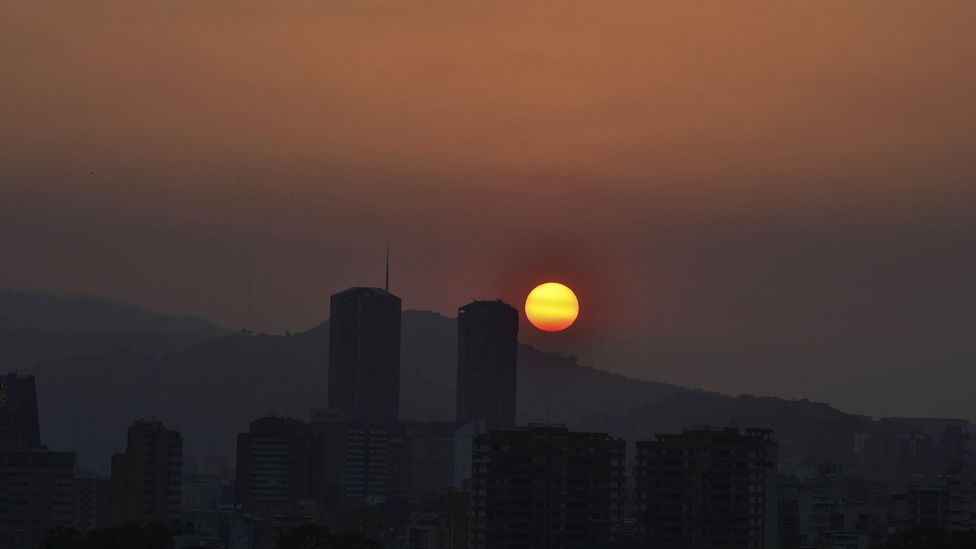
People can become trapped in lifts or in high-rise buildings during power outages (Credit: Getty Images)
A report by scientists at University College London mapped out how the loss of power can filter through communities, from the loss of health care provision and sanitation services to citizens trapped in lifts and disruption to transport systems.
Then there are the social consequences that percolate out. Crime rates often go up during blackouts as they provide opportunities for theft and fraud. The supply of cash and credit – particularly in our modern societies so reliant upon electronic and card payments – dry up meaning people have to rely on whatever cash they happen to have squirreled away. Communication networks and the ability to contact loved ones disappear, while vulnerable people like the elderly are often left stranded in their own homes.
Businesses are also left largely unable to operate, resulting in huge economic impacts. In 2004, the Department of Energy estimated the annual cost of power outages in the US to be around $80bn (£62bn) annually. When two million customers in California had their supplies cut for two days in October this year, experts estimated the cost to the economy to be around $2.5bn (£1.9bn).
Heltzel knows first hand the kind of chaos large-scale power outages can cause. He is a retired brigadier general who spent 33 years in the Kentucky National Guard and also served as the deputy commander of the Kentucky Joint Force Headquarters. In 2009, the state was hit by a series of ice storms that brought powerlines tumbling down under the weight of rime ice and snow building up on the wires.
"On one day we got an ice storm, followed by a snow storm, followed by another ice storm," recalls Heltzel. The build up of ice was so great it even brought down steel utility structures designed to withstand hurricane force winds and snapped wooden power poles "like toothpicks", according to a later Congressional hearing.
"We lost power in all of western Kentucky," says Heltzel. "From a state perspective, of 120 counties, we had 114 placed into a state of emergency. It meant that people were stuck in their houses and couldn't get to the stores to buy food. So, we had people that were going hungry and we had people whose wells were frozen over. They could not get water through the normal municipal water systems. At the same time the communications networks weren't working, so they could not call for help."
The Kentucky National Guard mobilised 12,000 soldiers and airmen to go door-to-door delivering food to people. They also requested emergency generators to get the water supply back up and running. Emergency communication stations were brought in from other states to restore the telephone and radio network.
Even so, the hardest hit areas were without power for weeks.
"We were flying people who managed the electricity grid up and down their power lines in our helicopters so they could assess how many poles and cables they needed," says Heltzel. "But even with all the resources we brought to bear, it took four and half weeks for the last house to be reconnected."
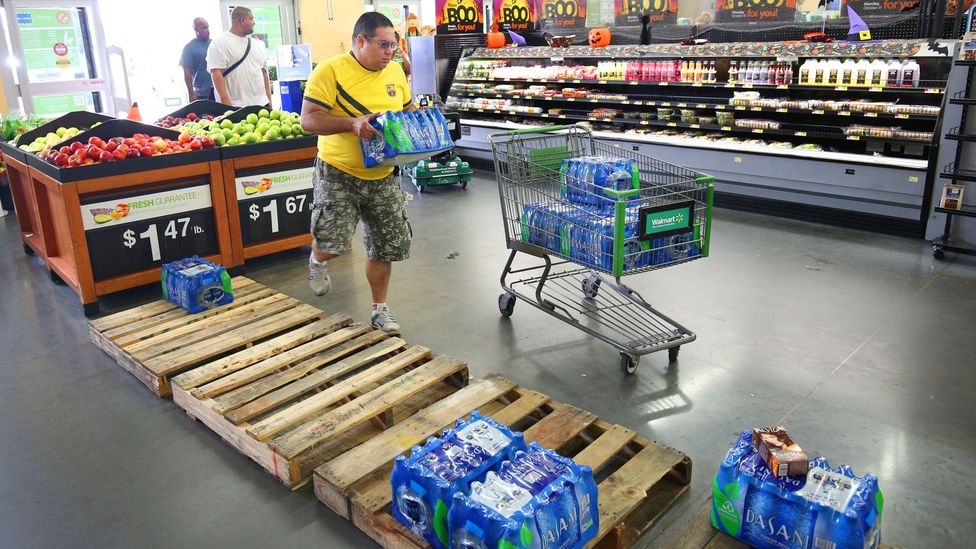
The Electric Infrastructure Security Council recommends having a two-week supply of bottled water at home in case of power cuts. (Credit: Getty Images)
Around 35 people in Kentucky and 30 in neighbouring states lost their lives. At least eight of the deaths were due to carbon monoxide poisoning due to diesel generators and kerosene heaters being used indoors without proper ventilation.
This is why Heltzel believes planning for a black sky event before one happens is so important. Organisations like hospitals, water suppliers and large companies can make sure they regularly service their back-up generators, and have a sufficient supply of fuel to keep them running. Churches and schools can make sure they have blankets on hand and other facilities to help those who might become stranded and need shelter.
On an individual level, we can all take steps too. From simple things like having torches with plenty of spare batteries to hand, to ensuring we have adequate supplies of bottled water to fall back on – the EIS recommends having two weeks worth of water with two litres a day per person and one litre for pets. Keeping cupboards stocked with non-perishable foods like rice, pasta and canned vegetables, is also advised.
But the Heltzel and his team also have some more unusual tips for families looking to prepare for a black sky event. Baby formula, for example, is a good source of nutrition even if you don't have young children. A good supply of rubbish bags is also important – these can be tucked under the toilet seat if the water stops running, allowing you to bury your waste outside.
Keeping a stash of emergency cash could also be a life saver.
"One of the things we talk about for individuals and families is turning yourself from being a survivor into someone who can help with the restoration," adds Heltzel. "We want people to be part of the solution rather than the problem. That might be being part of wider community efforts to build resilience or simply helping others who are not as prepared."
In Venezuela, the medical staff have become a perfect example of this. Following the first nationwide black outs, the number of deaths in hospitals have declined with each subsequent black out. Julio Castro, from Doctors for Health, puts this partly down to the shorter length of the power outages, but also to the preparations that hospital staff put in place.
"Now they are aware of the problem they have put procedures in place," says Castro. "They have made sure they have fuel and the back up generators are working. They have rotas for when they need to do manual ventilation and manual back ups for their equipment.
"It is keeping people alive."
This article was edited on 28 October 2019 to include quotes from Melissa Lott, research fellow at Columbia University, New York.
* Richard Gray is a senior journalist at BBC Future and can be found on Twitter @chalkmark.
--
Join one million Future fans by liking us on Facebook , or follow us on Twitter or Instagram .
If you liked this story, sign up for the weekly bbc.com features newsletter , called "The Essential List". A handpicked selection of stories from BBC Future, Culture, Worklife, and Travel, delivered to your inbox every Friday.
ransomsolockrapery.blogspot.com
Source: https://www.bbc.com/future/article/20191023-what-would-happen-in-an-apocalyptic-blackout
0 Response to "How Long Did the Blackout Continue"
Post a Comment